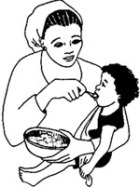Collected by: Kritee Lamichhane

1. World Health Organization (WHO) recommends breastfeeding should begin within one hour of birth
2. Breastfeeding should be “on demand”, as often as the child wants day and night (Usually 8-12 times in 24 hours), bottles or pacifiers should be avoided
3. A child must be exclusively breastfed for the first six months of life. Mother’s milk is enough for the child for the first 6 months. Water, honey or any other kinds of solid/liquid food must not be given to the child during the first 6 months.

4. At six months, solid foods, such as mashed food like rice, beans, pulses, eggs, fish, fruits and vegetables, should be introduced to complement breastfeeding for up to two years or more.
5. Breastfeeding should not be decreased when starting on solids. The food for the child as well as the container should be clean and safe. Breastfeeding must be continued until the child reaches 2 years of age.
6. Benefits of breastfeeding on infants:
- Breast milk is the ideal food for newborns and infants.
- It gives infants all the nutrients they need for healthy development.
- It is safe and contains antibodies that help protect infants from common childhood illnesses such as diarrhea and pneumonia
- Breast milk is readily available and affordable, which helps to ensure that infants get adequate nutrition
7. Benefits of breastfeeding on mothers:
- Exclusive breastfeeding is associated with a natural (though not fail-safe) method of birth control (98% protection in the first six months after birth).
- It reduces risks of breast and ovarian cancer, type II diabetes, and postpartum depression
7. Long-term benefits for children:
- Breastfeeding contributes to a lifetime of good health
- Adolescents and adults who were breastfed as babies are less likely to be overweight or obese.
- They are less likely to have type-II diabetes and perform better in intelligence tests.
8. Why avoid infant formula?
- Infant formula does not contain the antibodies found in breast milk.
- When infant formula is not properly prepared, there are risks arising from the use of unsafe water and unsterilized equipment or the potential presence of bacteria in powdered formula.
- Malnutrition can result from over-diluting formula to “stretch” supplies.
- While frequent feeding maintains breast milk supply, if formula is used but becomes unavailable, a return to breastfeeding may not be an option due to diminished breast milk production
9. HIV and breastfeeding:
- An HIV-infected mother can pass the infection to her infant during pregnancy, delivery and through breastfeeding.
- However, antiretroviral (ARV) drugs given to either the mother or HIV-exposed infant reduces the risk of transmission.
- Together, breastfeeding and ARVs have the potential to significantly improve infants’ chances of surviving while remaining HIV uninfected
- WHO recommends that when HIV-infected mothers breastfeed, they should receive ARVs and follow WHO guidance for infant feeding.
10. Regulating breast-milk substitutes (BMS Act): An international code to regulate the marketing of breast-milk substitutes was adopted in 1981. It calls for:
- all formula labels and information to state the benefits of breastfeeding and the health risks of substitutes;
- no promotion of breast-milk substitutes;
- no free samples of substitutes to be given to pregnant women, mothers or their families; and
- no distribution of free or subsidized substitutes to health workers or facilities.
11. Support for the breastfeeding mother is essential:
- Family of breastfeeding mother must create enabling environment so that the mother can adequately breastfeed her child.
- Routine practices, such as separation of mother and baby, and supplementation with infant formula, actually make it harder for mothers and babies to breastfeed.
- Health facilities must ensure baby friendly facilities and nutritional counselling services for the new mothers to encourage higher rates of the breastfeeding practice in proper frequency and position.

12. Working women and breastfeeding:
- Mothers need a safe, clean and private place in or near their workplace to continue breastfeeding.
- Enabling conditions at work, such as paid maternity leave, part-time work arrangements, facilities for expressing and storing breast milk, and breastfeeding breaks is a must at work place.
Reference:
WHO Fact File: 10 Facts on breastfeeding
Accessed at http://www.who.int/features/factfiles/breastfeeding/facts/en/ on 23rd May, 2017
Images: Google




